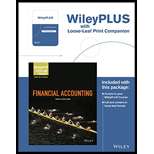
Concept explainers
(a)
Direct write-off method
This method does not make allowance or estimation for uncollectible accounts, instead this method directly write-off the actual uncollectible accounts by debiting
To prepare: The
(b) (1)
Percentage-of-sales basis:
It is a method of estimating the bad debts (loss on extending credit), by multiplying the expected percentage of uncollectible with the total amount of net credit sale for a specific period. Estimated bad debts would be treated as a bad debt expense of the particular period.
To Prepare: The
(b) (2)
Percentage-of-receivables basis:
It is a method of estimating the bad debts (loss on extending credit), by multiplying the expected percentage of uncollectible with the total amount of receivables for a specific period. Estimated bad debts would be treated as a target allowance balance.
To Prepare: The adjusting journal entry for recording the bad debt expense for the year, under allowance method, if bad debt expenses are expected to be 10% of accounts receivable.
(c) (1)
Percentage-of-sales basis:
It is a method of estimating the bad debts (loss on extending credit), by multiplying the expected percentage of uncollectible with the total amount of net credit sale for a specific period. Estimated bad debts would be treated as a bad debt expense of the particular period.
To Prepare: The adjusting journal entry for recording the bad debt expense for the year, under allowance method, if bad debt expense are expected to be 0.75% of net sales.
(c) (2)
Percentage-of-receivables basis:
It is a method of estimating the bad debts (loss on extending credit), by multiplying the expected percentage of uncollectible with the total amount of receivables for a specific period. Estimated bad debts would be treated as a target allowance balance.
To Prepare: The adjusting journal entry for recording the bad debt expense for the year, under allowance method, if bad debt expenses are expected to be 6% of accounts receivable.
Want to see the full answer?
Check out a sample textbook solution
Chapter 8 Solutions
Financial Accounting, 10e WileyPLUS Registration Card + Loose-leaf Print Companion
- Please provide the solution to this general accounting question with accurate accounting calculations.arrow_forwardI need the correct answer to this general accounting problem using the standard accounting approach.arrow_forwardYou are employed by an external audit firm that is hired by JBltd, a privately owned incorporated business. Accounting records are maintained on a computer using proprietary software. You have worked on the audit for three years and this year you are in charge of the audit. Your assistant is a newly recruited business graduate who has done an accounting course but has no practical experience. Because of the small size of the company there is limited opportunity for segregation of duties. You decide, as in previous years, that the appropriate audit strategy is to obtain evidence primarily through the performance of substantive procedures. You also plan to perform the audit around the computer as the proprietary software is known to be reliable and details of all transactions and balances can be readily printed out. On arriving at the company's premises in December 2019 to perform the final audit on the 31 October 2019 financial statements, you obtain a copy of the year end bank…arrow_forward

 AccountingAccountingISBN:9781337272094Author:WARREN, Carl S., Reeve, James M., Duchac, Jonathan E.Publisher:Cengage Learning,
AccountingAccountingISBN:9781337272094Author:WARREN, Carl S., Reeve, James M., Duchac, Jonathan E.Publisher:Cengage Learning, Accounting Information SystemsAccountingISBN:9781337619202Author:Hall, James A.Publisher:Cengage Learning,
Accounting Information SystemsAccountingISBN:9781337619202Author:Hall, James A.Publisher:Cengage Learning, Horngren's Cost Accounting: A Managerial Emphasis...AccountingISBN:9780134475585Author:Srikant M. Datar, Madhav V. RajanPublisher:PEARSON
Horngren's Cost Accounting: A Managerial Emphasis...AccountingISBN:9780134475585Author:Srikant M. Datar, Madhav V. RajanPublisher:PEARSON Intermediate AccountingAccountingISBN:9781259722660Author:J. David Spiceland, Mark W. Nelson, Wayne M ThomasPublisher:McGraw-Hill Education
Intermediate AccountingAccountingISBN:9781259722660Author:J. David Spiceland, Mark W. Nelson, Wayne M ThomasPublisher:McGraw-Hill Education Financial and Managerial AccountingAccountingISBN:9781259726705Author:John J Wild, Ken W. Shaw, Barbara Chiappetta Fundamental Accounting PrinciplesPublisher:McGraw-Hill Education
Financial and Managerial AccountingAccountingISBN:9781259726705Author:John J Wild, Ken W. Shaw, Barbara Chiappetta Fundamental Accounting PrinciplesPublisher:McGraw-Hill Education





